Closed April 28, 1977 | ||
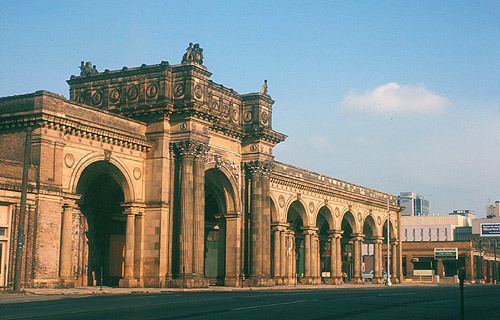 | ||
Similar LeVeque Tower, Columbus City Hall, Schiller Park - Columbu, Rhodes State Office Tower, Westland Mall | ||
Columbus Union Station and its predecessors served railroad passengers in Columbus, Ohio from February 27, 1850, until April 28, 1977.
Contents
- History
- The first station 1851
- The second station 1875
- The problem crossing High Street
- The third station 1897
- Decline and demolition 1976 1979
- Railroads in the order they entered Union Station
- References
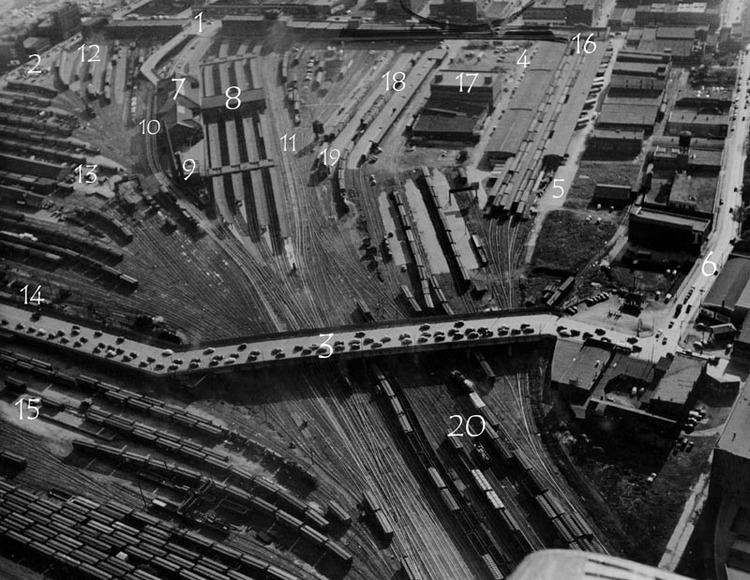
History

Columbus Union Station, as it is recalled today, was the third Union Station in Columbus. The previous two served in the nineteenth century, and their replacement and upgrade reflected the rapid growth in traffic and importance of Columbus' railroads at that time. The subsequent decline in rail passenger traffic following World War II was reflected in Union Station's demolition and replacement with a convention center in the early 1980s.
The first station (1851)
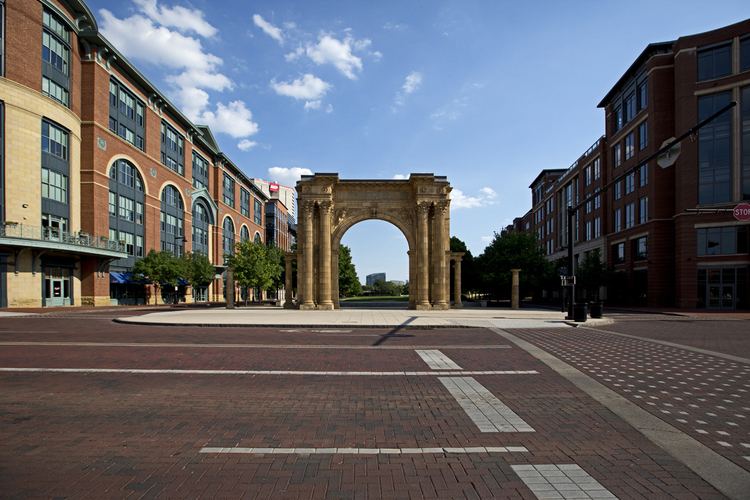
In 1851, a site north of Naughten Street and east of High Street was purchased jointly from Orange Johnson by the Columbus and Xenia Railroad (C&X) and Cleveland, Columbus and Cincinnati Railroad (CC&C). A wood barn structure measuring 90 by 175 feet (27 by 53 m) was installed to serve passengers, the rest of the site given over to shops and freight tracks. The station had three tracks for loading and unloading of passengers. In 1853, the Central Ohio Railroad entered the city and connected to the station. In 1864, the Steubenville and Indiana Railroad was connected the Central Ohio at Newark, and entered the station on shared tracks. This road was called the "panhandle route" because it crossed the panhandle of West Virginia on its way east. The station was inadequate and in 1868 the railroads formed the Union Depot Company to undertake a replacement.
The second station (1875)
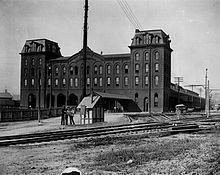
In May, 1873 work was begun on the second union station north of the existing station, and it opened on February 14, 1875. The first station was then demolished. Compared to its wooden predecessor, this new station was far more substantial. Constructed of brick, it had a large waiting room, ticket offices and railroad offices at the front of the structure. Seven tracks entered the structure and a long train shed kept passengers dry. In 1875, 42 daily passenger trains departed from the station.
The problem crossing High Street
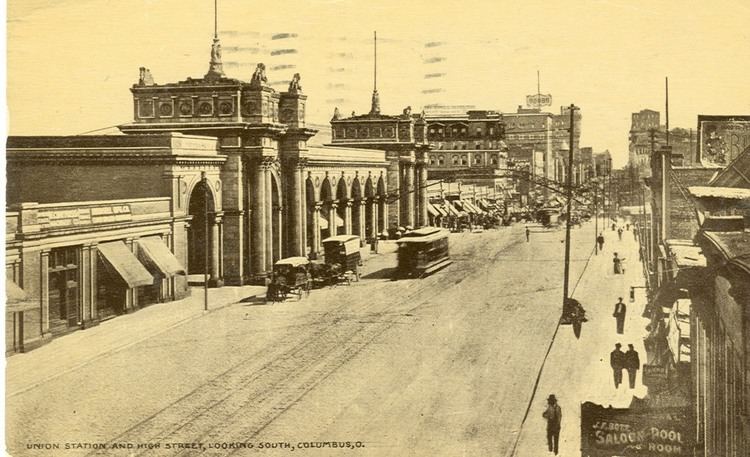
The City of Columbus continued to grow northward with the opening of The Ohio State University in 1870. With the opening of the new union station, thirteen tracks now crossed north high street. The congestion between train and road traffic became unbearable. In 1875, a $45,000 tunnel was built under the tracks to allow streetcars and horsecarts to pass under the tracks. An extra mule was stationed at the tunnel entrance to assist horsecars up the steep grade. The tunnel was 150 feet (46 m) long with 550-foot (170 m) approaches on either side. It was so dark and smelly that only the horsecar passengers, who had no other choice, would use it.
The third station (1897)
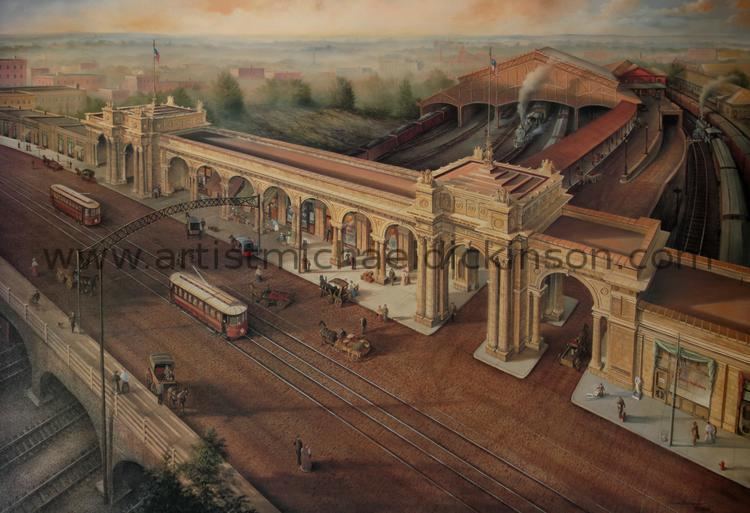
In 1891 the traffic situation on High Street reached a crisis, with the roadway blocked for up to seven hours per day by crossing trains. In 1893 the architectural firm of Daniel H. Burnham & Company of Chicago began planning a new facility. A key feature of the new station would be a road viaduct over the tracks, finally solving the traffic/train problem on North High Street. In 1893 the old station was handling 112 passenger trains per day.
The new station opened in 1897, and the Arcade was finished in 1899. The Arcade was unique to Columbus and consisted of stores and offices built atop the viaduct and facing High Street. An elevated roadway connected High Street to the station to the east. The station increased the number of depot tracks from seven to nine.
The architecture of the station drew on Burnham's experience designing the Chicago World's Fair in 1893. The style was Beaux-Arts Classicism, a late 19th-century style often applied to monumental structures.
In May 1928, part of the Arcade was demolished to expand the driveway to the station to better accommodate automobiles. Service moved from the Toledo and Ohio Central Railroad Station to Union Station in 1930. In April 1931, the train shed was replaced with an enclosed concourse. In 1956, Columbus was down to 42 daily passenger trains, the lowest number since 1875.
Daily passenger trains fell to 21 in 1962, and just 10 in 1970. It was clear that the completion of the interstates and popularity of automobiles would soon mean the end of passenger rail service in Columbus. On May 1, 1971, Amtrak took over most of what was left of passenger service in the United States.
Decline and demolition (1976-1979)
At 6 pm on Friday, October 22, 1976 the deteriorating Arcade was demolished by a consortium led by the Battelle Memorial Institute to make way for a new convention center. This despite the arcade having been listed on the National Register of Historic Places two years earlier. The demolition was timed to turn the building into rubble before preservationists could act. A restraining order by a judge halted demolition, but it was too late and only one arch of the ornate structure was saved. It remains on display in the Arena District's Dimon McPherson Park directly across Nationwide Boulevard from Nationwide Arena. The land the arch sits on was formerly occupied by the Ohio Penitentiary.
While the Arcade was gone, Union Station continued to serve rail passengers even as the number of trains dwindled to one daily, and the restaurant and newsstand closed. On April 28, 1977, the last train Amtrak's National Limited departed Union Station at 9:17 am for Kansas City. The cost of operating the station was too great, so it was replaced with a metal shed located east of the station near the 4th Street viaduct.
The station was finally demolished in September 1979. The need for the yards and servicing facilities for freight traffic had been eliminated by the construction of the new Buckeye Yard west of the city by the Penn Central in the late 1960s. The multitrack yards and shop areas eventually gave way to I-670 in the early 1990s. Interestingly, the viaduct over I-670 was constructed with a cap, and shops lining High Street reminiscent of the long gone Arcade. However, as part of the 3-C Plan, there are plans to build a new multi-modal station on at least part of the site of the former rail terminal. It is planned to be located between the Ohio Center and the Greater Columbus Convention Center. A future streetcar or light rail line could be built on the west end of the proposed station.
